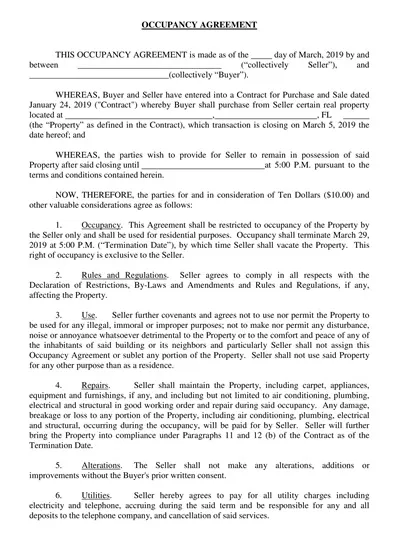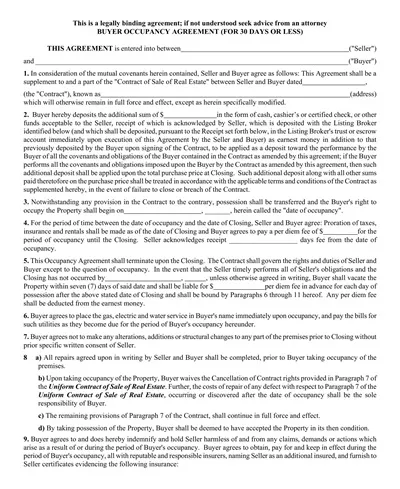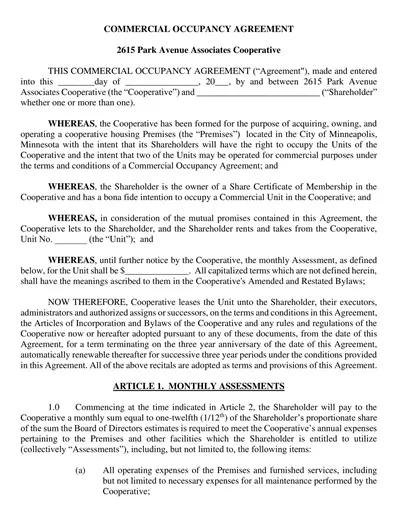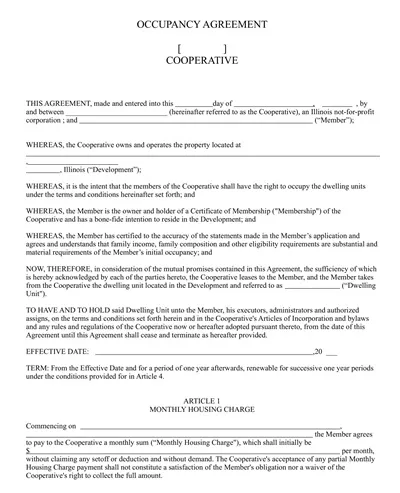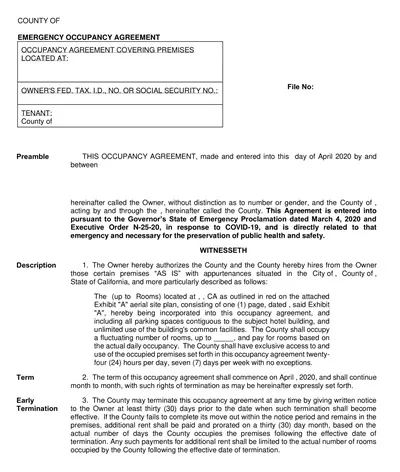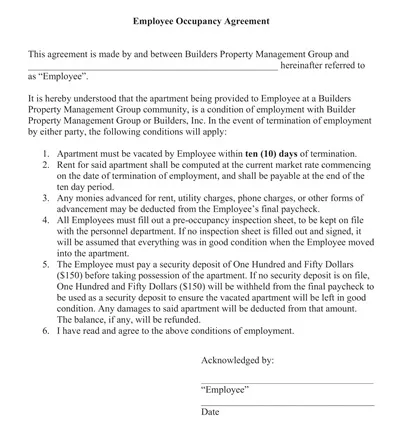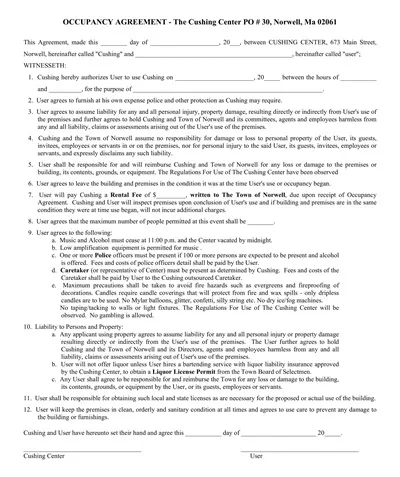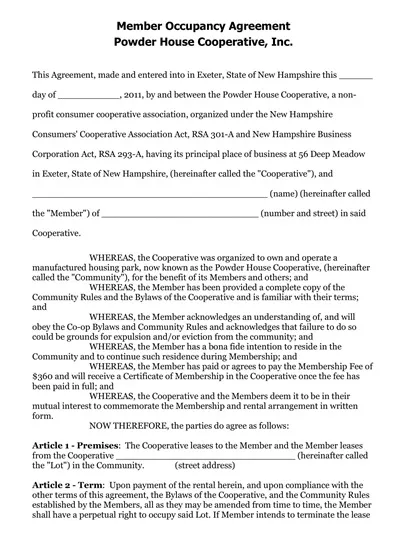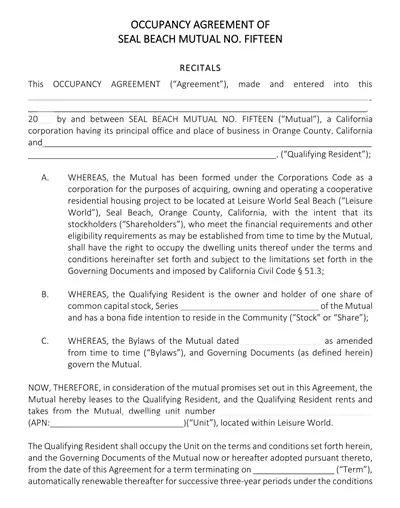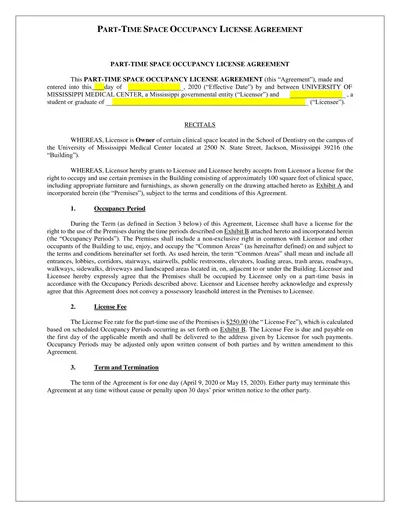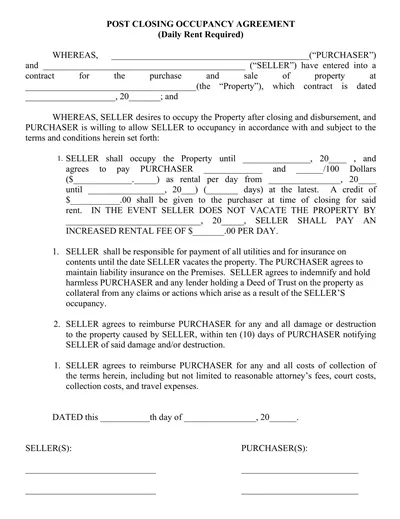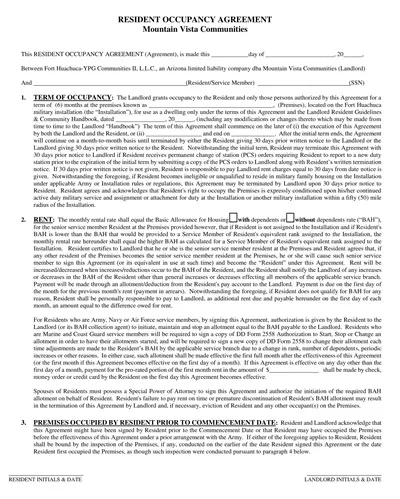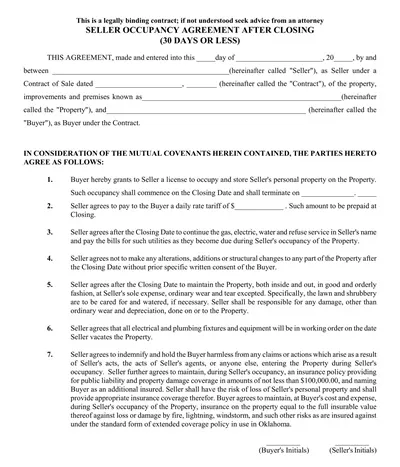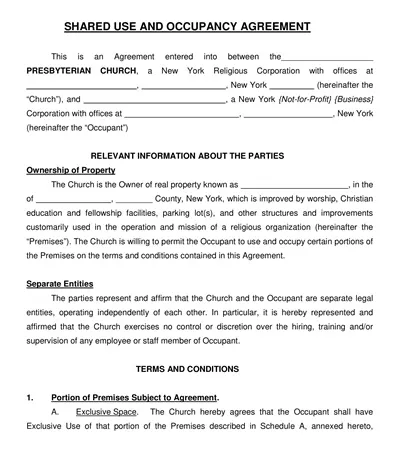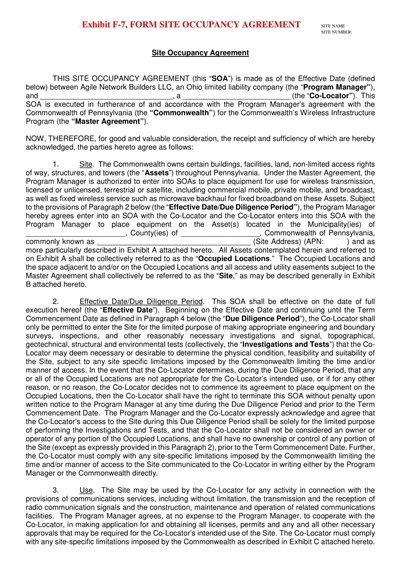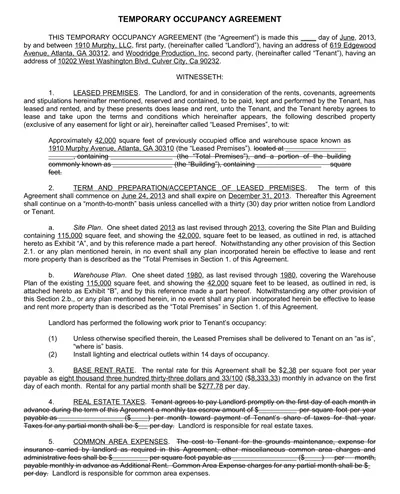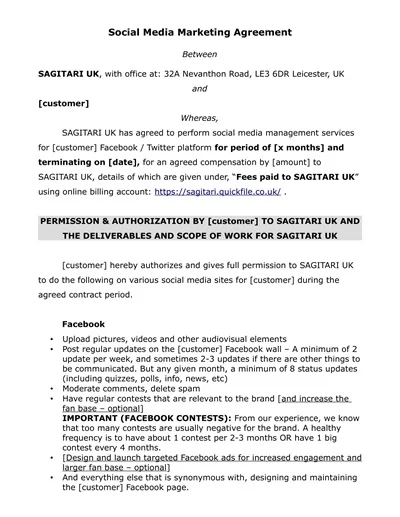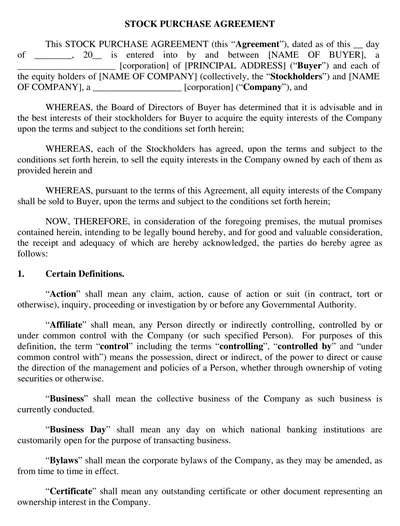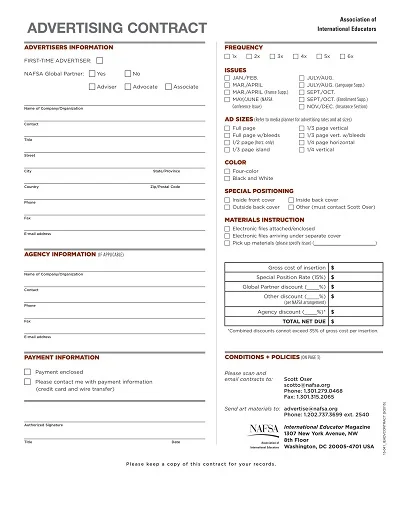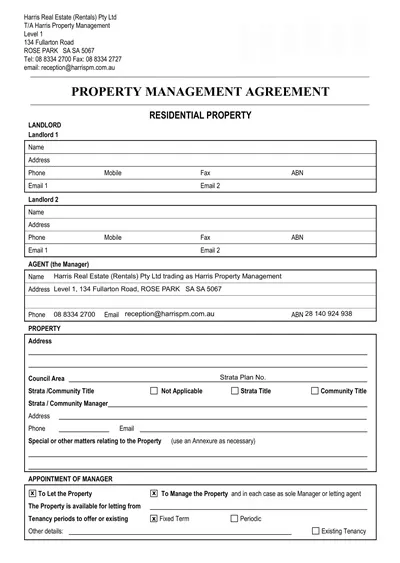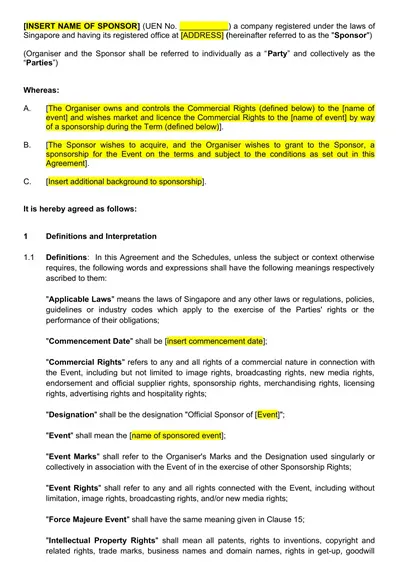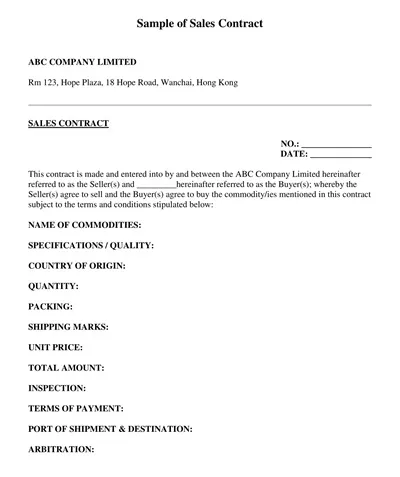An Occupancy Agreement Template presents an established document to specify residence conditions for property occupancy. The template functions as an indispensable basis to establish lawful and understandable contracts between property owners or managers and their occupant parties.
This template includes key sections that detail important aspects of occupancy duration together with payment obligations and responsibilities alongside termination criteria. The Occupancy Agreement Template provides essential tools that create transparent agreements to prevent misunderstandings therefore, it represents a vital resource in property management operations.
Download Free Sample Occupancy Agreement Templates
What Is an Occupancy Agreement?
A document known as the Occupancy Agreement defines all legal obligations between an owner or manager of the property and their occupying tenant across the occupancy period. An Occupancy Agreement serves instead of regular rental and lease contracts for arrangements that fail to meet formal tenancy requirements.
Occupancy Agreements serve properties under temporary living and residential sharing plans and business operations. The agreement outlines all important components, including payment rules, terms for us,e and procedures for termination, which provide legal bases for resolving potential disputes between contracting parties. The central purpose of an Occupancy Agreement is to establish a dependable and open partnership between stakeholders who maintain mutual trust and work together cooperatively.
Components of an Occupancy Agreement
A good Occupancy agreement is comprised of several very vital parts that contain simplicity and hold down the possibility of a fight. These components include:
- Parties – The contract should specify the property owner or manager and the tenant: their full names and their contact details.
- Property Description – A full description of the property or space being used should be given, with an emphasis on the location, size, as well as any shared or exclusive areas.
- Term of Occupancy – The document should include the beginning and end dates of the occupancy period, or if the arrangement is month-to-month, specify that date is not applicable.
- Payment Terms – This section lists out the occupant’s financial duties, such as the amount, frequency, and method of such payments, as well as any charges charged by way of punishment (late fees) on no payment.
- Use of the Property – Express rules about what can and cannot be done with the property is crucial. This could be anything from a rule about overnight visitors and/or noise levels to what is not allowed to occur.
- Responsibilities and Maintenance – Information on the roles each party will play in taking care of the property should be clearly defined, including repairs, utilities, and routine maintenance.
- Termination Provisions – The agreement must specify the paramount conditions as to when the agreement must come to an end and let the premise of a fair homing a lawful termination.
- Dispute Resolution – Including a clause on what form of disputes will be resolved, including mediation or litigation, enables both parties to efficiently manage conflicts.
By including these important components in the Occupancy Agreement, both parties will be able to understand their roles and responsibilities clearly, giving rise to a cooperative and peaceful occupancy relationship.
Benefits of Having an Occupancy Agreement
Having a good draft of the Occupancy Agreement provides numerous advantages to the homeowner and the occupant. Firstly, it gives a clear, legally enforceable, and unambiguous framework of the rights and duties of each side; it avoids discrepancies or differences. This clarity offers a feeling of security for both parties, who are aware of exactly what the other party is required of them.
In addition to this, the Occupancy Agreement encourages accountability, as it defines the particular control for property management, pay of rents, as well as implementation of steps of use. It also streamlines any disputes, as often there is an agreement of procedures for dispute resolution as part of the contract.
For the property holder, it is a protection in opposition to the chance of abuse of the property, while for the resident, it makes certain equitable treatment and openness. Eventually, an Occupancy Agreement promotes a cooperative and professional relationship conducted on a win-win footing based on common respect and trust.
Terms to Include in an Occupancy Agreement
An Occupancy Agreement needs to be detailed and organized to take in the one-of-a-kind needs of the two parties. Following are the essential terms to incorporate, along with the vital information related to it:
1. Property Description
Specifically, Abbreviate the subject property, which comprises its address and any particular room, amenities, or parking spaces outlined in the contract. This means no doubt is being provided to occupy.
2. Duration of Occupancy
State the start and end dates of the contract, whether or not the contract is a fixed-term contract and will renew automatically periodically, with the specifics of how much notice, if any, will be needed for termination or extension.
3. Payment Terms
Specify the amount of rent or fees, payment due date, accepted payment methods, as well as any consequences of making late or missed payments. Full transparency in financial obligations prevents disputes in the future.
4. Security Deposit
Specify how much the holding deposit is, why it is, and what conditions recover. Report all potential damages, unpaid hire, or cleaning fee deductions.
5. Rights and Obligations of Each Side
Outline duties like maintaining the property, who is answerable for repairs, as well as paying for utilities. This part should set out who is responsible for expenses arising from maintenance or unforeseen problems.
6. Use of the Property
Notarize any limitations on the use of the property, for example, prohibitions on subletting, business-based, or housing of pets. By establishing these rules beforehand,d it prevents possible conflicts.
7. Termination Clauses
Outline the procedure for canceling the agreement,t such as notice periods and a list of acceptable reasons for terminating the agreement early by either side. Also, list out the consequences in case of a breach of contract.
8. Dispute Resolution
List the ways to resolve disputes, mediation, arbitration, or lawyers. A clear dispute resolution clause prevents time and money issues when disagreements occur.
9. Insurance Requirements
Tell tenants whether they must carry renter’s insurance to cover personal effects or liability. For property owners, mention details of insurance coverage on the property itself.
10. Inspection Terms
List clauses regarding property inspections, defining the timing, method, and type of notice necessary before entry requirements. It provides the resident with privacy and access for the property owner when needed.
By adding these words into an Occupancy Agreement, both the property owner and the Occupant know exactly how they will get along under mutually fair terms.
How to Create an Effective Occupancy Agreement Template
Establishing an excellent occupancy agreement template is vital for property owners and renters alike to set clear expectations and achieve a peaceful rental experience.
Here are the key How to steps:
- Outline Major Points: Begin by knowing what major points to put into the agreement, such as property information, payment terms, and responsibilities of each contracting party.
- Find Local Laws: Find out if any local regulations or legislation can affect the agreement’s terms and conditions.
- Speak Clearly, Simply: Be direct in the language you use, and that is easy for both people to understand. Steer clear of legal terms that could be ambiguous or brought into question.
- Cover All Important Clauses: Ensure all key clauses are contained, like clauses for termination and for the settlement of disputes.
- Discuss Customization: Think about including the ability to customize some things based on the needs of the individual residents, such as adding extra rules for the use of shared areas or additional maintenance requirements.
- Get a Lawyer Involved: It is always a good idea to hire a lawyer to go over the contract with the agreement before signing it so that it will be valid under the law and both parties are protected.
Preparing a good occupancy agreement template needs one to be specific as well as have an excellent understanding of the legal implications for both parties. By following these steps and keeping the template up to date as required, property owners can guarantee a fair and stress-free rental experience for all tenants.

